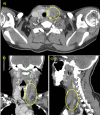A Rare Case of Lemierre's Syndrome due to Veillonella Parvula: A Dangerous and Forgotten Complication of a Septic Condition
- PMID: 39130348
- PMCID: PMC11306480
- DOI: 10.1007/s12070-024-04615-w
A Rare Case of Lemierre's Syndrome due to Veillonella Parvula: A Dangerous and Forgotten Complication of a Septic Condition
Abstract
This clinical case presents an unusual case of Lemierre's syndrome (LS) in a young woman of 38-year-old. She arrived in the Emergency Department with a high fever and pharyngology resistant to antibiotic therapy with clarithromycin, ceftriaxone, and cortisone for two weeks. At the blood sampling, there is a marked leucocytosis, and the advice of the otolaryngologist is required given the strong pain in the throat. Due to the tonsillar abscess, a neck CT with a contrast medium is necessary for the otolaryngologist's opinion. The CT shows thrombosis of the jugular vein and left subclavian, with thickening of soft perivascular tissues; these findings suggest Lemierre's syndrome: a septic thrombophlebitis of the jugular vein that occurs as a complication of a peritonsillar abscess. The diagnostic process is then completed with a chest HR-CT, which reveals lung density and excavation areas suggesting tuberculosis. Blood culture reveals the presence of Veillonella Parvula (an anaerobic gram-negative coccus), sputum culture reveals the presence of some colonies of Enterobacter cloacae complex, real-time PCR examination on sputum reveals the presence of Streptococcus Pneumoniae and the borderline presence of rhinovirus. Microbiologists, after these results and neck and chest CT with a contrast agent, agree with the diagnosis of suspected LS at an early stage: a septic dissemination fortunately limited only to the neck and lungs region.
Keywords: Enterobacter cloacae; Leimerre’s syndrome; Oropharyngeal infection, thrombophlebitis; Septic emboli; Veillonella parvula; Vein thrombosis.
© The Author(s) 2024.
Conflict of interest statement
Conflict of InterestThe authors have no competing interests to disclose.
Figures




References
LinkOut - more resources
Full Text Sources
